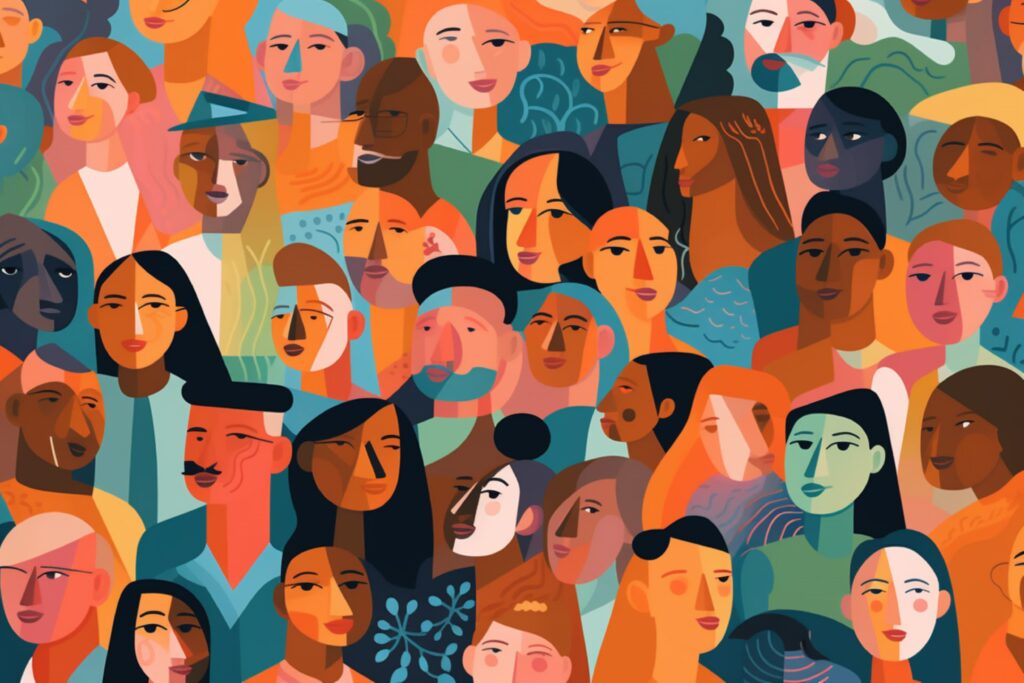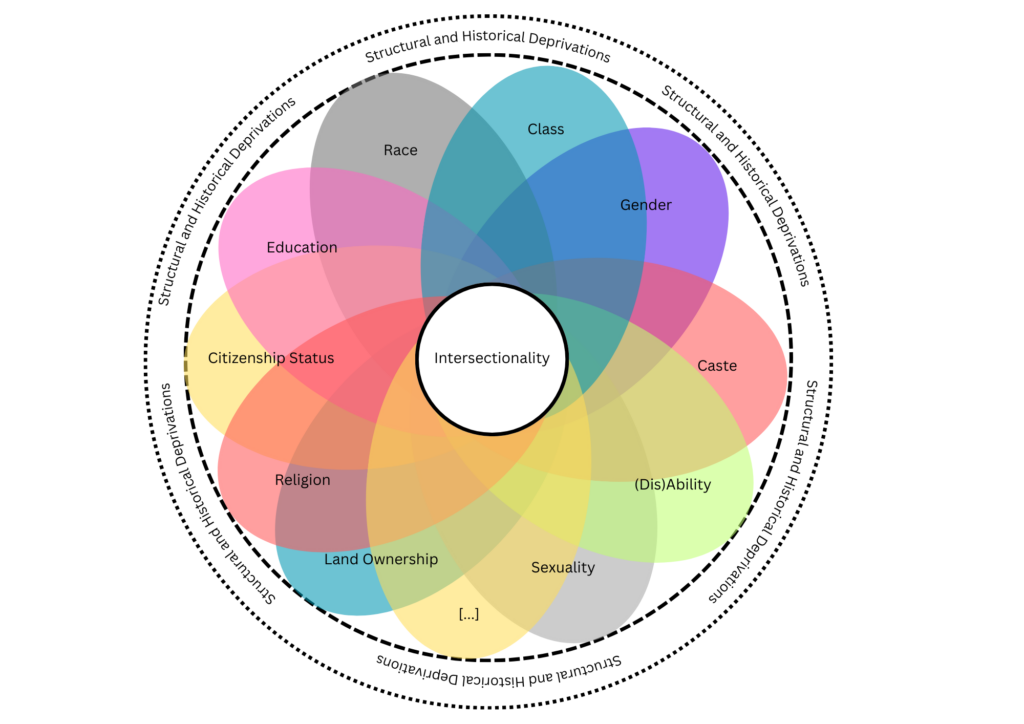
The ecological crises we face today don’t impact everyone the same way, and marginalised people are often impacted disproportionately. MAPS researchers have developed pioneering guidelines to ensure multiple, interconnected social injustices are addressed in our project work.
What are intersectional injustices? Intersectional injustices refer to the discrimination and disadvantages experienced by individuals or groups who are structurally disadvantaged in not one, but multiple ways. As the image below shows, interconnected social injustices related to race, class, gender, geography, (dis)ability, sexuality, caste, education, and others can intersect. When they do, unique structural discriminations and disadvantages arise.
For example, the discrimination a white Belgian woman faces, is much different from that of a Black queer person seeking asylum. The injustices the Black queer person is likely to experience are not “just” discriminations related to Blackness, queerness, and citizenship. Instead, they take on a unique form that cannot be explained by simply adding up the experiences of a ‘prototypical’ person from each category.

(UN) Intersectionality Resource Guide and Toolkit. Image by Pooja Patki.
The MAPS project commits to intersectional justice as a guiding principle and cross-cutting theme. But how can this commitment be enacted in practice? What efforts can a research project undertake to promote intersectional justice?
To start with, it is important to recognise that efforts to promote intersectional justice can be made at all stages of research projects: from hiring to different phases of the research process to the final communication of acquired insights. Doing so involves engaging in a process of continuous (un)learning and an explicit acknowledgement of biases and omissions.
Project management underpins all work done as part of the MAPS project. An intersectional approach to project management will increase awareness for a project team’s diverse positionalities. It helps finding ways to counteract intersectional injustices within the MAPS team. And it promotes a collaborative and inclusive workspace.
Reflections on positionalities can help reveal invisible power relations and the influence they have on research practices. Within MAPS, this means acknowledging that our team consists mostly of white and able-bodied researchers from (mostly Western) Europe. Future hiring can take this fact into account to ensure that a wider spectrum of perspectives is included in the project work. This can render findings more objective as they become less dependent on group-specific values and contexts. Acknowledging that even the best intentions and reflexive settings may not prevent (re)producing intersectional injustices, MAPS establishes a support group. Any MAPS member can approach this group to speak confidentially, and to find solutions when issues of discrimination, dominance, or untenable hierarchies arise during their project work.
Intersectional justice should also guide the actual research process – not only in theoretical work and literature reviews, but also in applying qualitative and quantitative research methods. In theoretical work and literature reviews it is important to acknowledge institutionalized mechanisms of exclusion (along the lines of language, open access funding etc.) that often lead to rather homogeneous perspectives and reference lists. Walking the extra mile to go beyond dominant perspectives is important to live up to intersectional justice as a guiding principle.
Applying intersectional justice principles to research methods requires researchers to be mindful of overlapping systems of oppression. Researchers can make their qualitative approaches more intersectionally just by paying attention to the identities and experiences represented in their samples. Depending on the research question at hand, researchers may explicitly include or even over-sample commonly overlooked groups (such as people of colour, working class, non-binary people, etc.).
In their quantitative work, researchers make decisions on methods, dataset, sample size, and time horizon. To align discussions on these decisions with intersectional justice, researchers can reflect on their respective positionality, potentially present biases, and how to overcome them. In analysing regression analysis outputs, it is important to acknowledge that outliers or missing data points represent real people with real experiences. Omitting data means omitting particular experiences. For example, queer couples and non-binary people tend to be treated as outliers in time-use studies. This might make sense from a statistical point of view, but it also reproduces intersectional injustice. To avoid this, quantitative researchers can explicitly acknowledge limitations, point to the literature on intersectional justice, or complement quantitative methods with qualitative insights on, for example, the time-use of queer couples.
Finally, research projects can apply intersectional justice principles to their communication and dissemination activities. The Guidelines recommend that communicators adopt inclusive language to make content accessible not only to experts but also to the broader public. Besides, they should choose examples to illustrate findings that speak to not only a niche, but a variety of audiences who then can find themselves represented. Project webpages can be made accessible to those with visual impairments by choosing accessible fonts and colours. Research projects can also implement IJ principles by offering public speaking opportunities to its younger researchers on conferences and public events. Team members can support them by offering encouragement and training.
Applying the project guidelines on intersectional justice to MAPS’ different project areas can help enhancing the overall impact and integrity of our project by recognising and redressing intersectional injustices. Post-growth policies developed as part of MAPS aim to incorporate the needs of marginalised populations while aligning with the broader goals of a good life for all within planetary boundaries. We hope that these Guidelines can help other research projects in their reflections on how they can embrace intersectional justice as a guiding principle and cross-cutting theme.
Download the full report below:
The full report may be cited as:
Patki, Pooja; Dengler, Corinna; Barlow, Nathan; Heck, Lukas (2025). MAPS Project Guidelines on
Intersectional Justice. The MAPS Project, Vienna University of Economics and Business, Vienna,
Austria.

